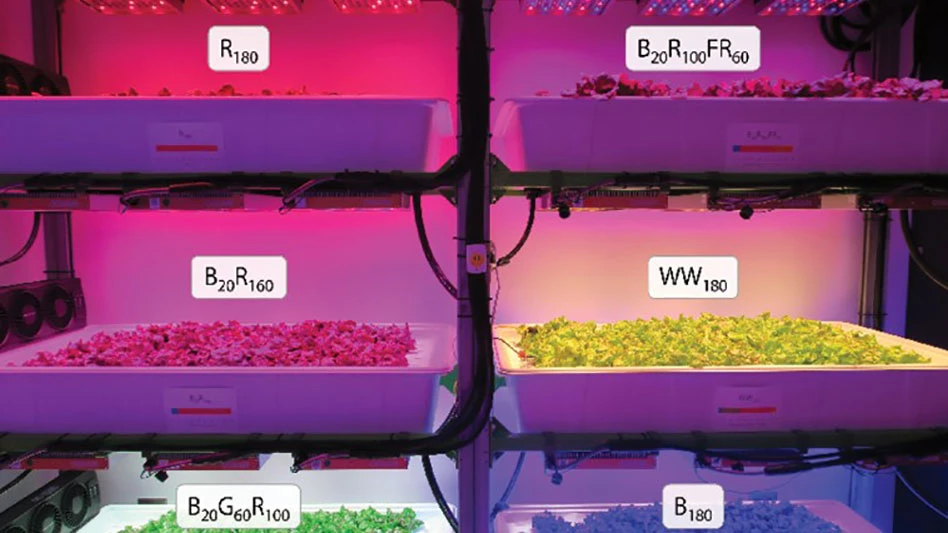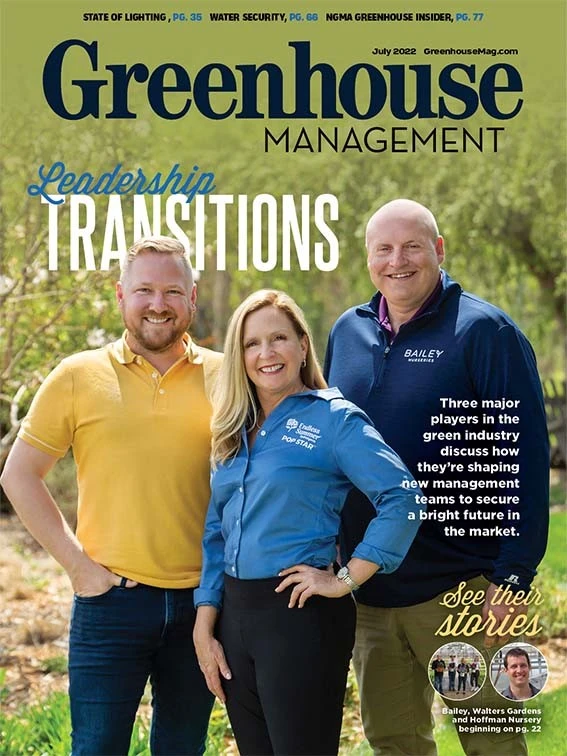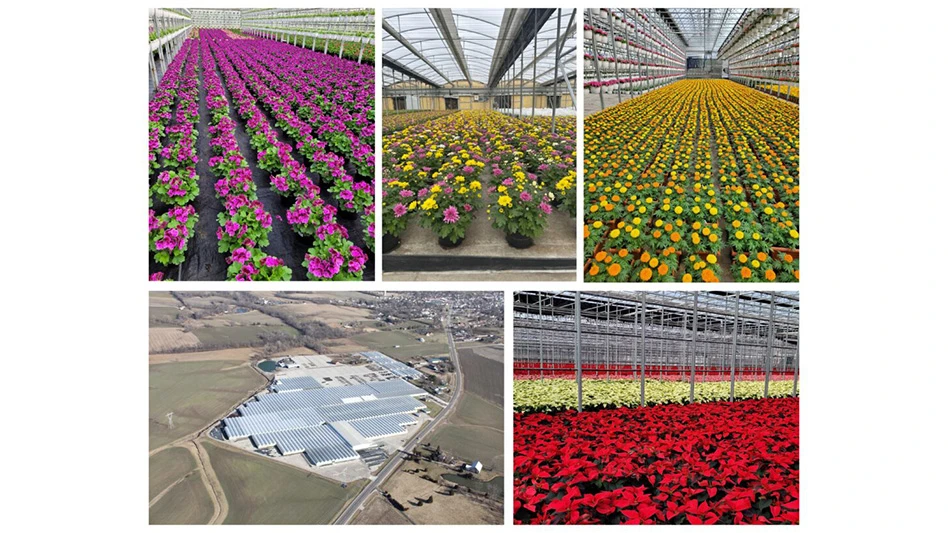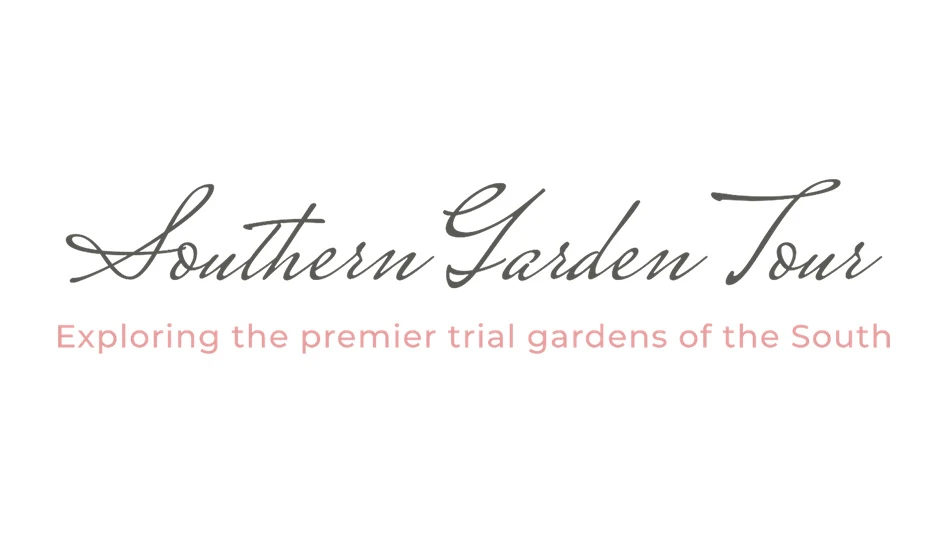

Many indoor vertical farmers grow leafy greens under the same, fixed light spectrum from seed to harvest. Some produce seedlings under one light spectrum in the propagation area, and after transplant, use a different light spectrum in the finish area. The idea is to: 1) apply more blue light (and less red light) to produce compact, easy-to-transplant seedlings; and then 2) apply less blue light (and more red light) to promote the growth rate (yield) of maturing plants.
The dynamic delivery of different light spectra during different plant growth phases is not new. For example, in cannabis production, more blue light in the vegetative phase makes plants more compact, while less blue light in the flowering phase can maximize lighting efficiency. Moreover, when greenhouse red-leaf lettuce lacks red color under low light in winter, growers can provide blue-rich supplemental lighting a week before harvest to boost anthocyanin production and thus intensify red color. This is end-of-production lighting, which applies to both greenhouses and indoor vertical farms.
These cases aside, the benefits of using different light spectra for seedlings and maturing plants have been mostly anecdotal. How does a fixed light spectrum directly compare to dynamic light spectra when it comes to crop yield and size? Is it worth the hassle of moving seedlings to a different light spectrum during production, or investing in color-tunable lighting fixtures? To answer these questions, we designed and conducted an indoor lettuce experiment.
Experiment protocol
We sowed seeds of red-leaf lettuce ‘Rouxai’ in rockwool cubes, covered them with transparent domes, and immediately placed them under color-tunable light-emitting diode (LED) fixtures. Plants in six trays received six different light spectrum treatments at the same total light intensity (photon flux density) of 180 µmol·m–2·s–1 (400–800 nm) and 20-hour photoperiod. The six light spectrum treatments below (and shown in Fig 1.) were warm-white (WW), red (R), and blue (B) light, as well as combinations of R+B light with green (G) or far-red (FR) light. The subscript after each light color is its light intensity in µmol·m–2·s–1.
WW180
R180
B20R160

B20G60R100
B20R100FR60
B180
We removed the domes on day 4 and sub-irrigated seedlings with a nutrient solution (EC ˜ 1.6 dS·m–1, pH ˜ 5.8). We grew plants at a constant temperature setpoint of 73° F (23° C) without CO2 enrichment. On day 11, we collected growth data on 10 seedlings from each of the six light spectrum treatments. In addition, we transplanted seedlings into floating rafts of a deep-flow-technique hydroponic system under the six light spectrum treatments. The nutrient solution was constantly recirculated and aerated (EC ˜ 1.8 dS·m–1, pH ˜ 6.1).
At transplant on day 11, we switched the light spectrum treatments but maintained the same temperature. For 60 seedlings grown under each treatment from days 0 to 11, we continued to grow 10 of them under the same treatment and moved 10 of them to finish under each of the other five treatments. By alternating between the six treatments for the seedling phase and the same six treatments for the finish phase, we created 36 light spectrum schedules. We harvested all plants and collected growth, size and coloration data on day 25 (14 days after transplant).
Results
Fixed light quality
In general, lettuce responded to fixed light spectrum treatments similarly whether harvested as seedlings on day 11 or mature plants on day 25 (Fig. 2). When plants were grown under a fixed light spectrum from days 0 to 25, final shoot fresh weight was the highest under R180 (no blue) and WW180 (7% blue), and the lowest under B180 (all blue). Adding 11% blue to red light decreased yield by 29%. Yield under all blue light was 65% lower than that under all red light. Blue light decreased crop yield and size but increased red leaf color. Red-leaf lettuce grown under all red light was not “red-leaf” lettuce because it had mostly green leaves, with little red color.
In addition to the red + blue light treatment, we partially substituted green or far-red light for red light. Compared to B20R160, adding green light to red + blue light (B20G60R100) decreased yield by 19%, whereas adding the same intensity of far-red light to red + blue light (B20R100FR60) increased yield by 22%. Including green light created white light, making it easier to see the true colors of plants, although this came at the expense of yield. Far-red light promoted leaf expansion, allowing plants to capture more light to increase photosynthesis and thus yield. Both green and far-red light slightly reduced red leaf color.

Dynamic light quality
We photographed representative plants from all 36 light spectrum schedules (Fig. 3). Plants in dashed circles received the same light spectrum from days 0 to 25. In contrast, the other plants received dynamic light quality, with one light spectrum applied from days 0 to 11 (before transplant) and a different light spectrum applied from days 11 to 25 (after transplant).
When plants were grown under different light spectra before and after transplant, both light spectra influenced final shoot fresh weight. The light spectrum delivered after transplant had similar effects on final yield as a fixed spectrum delivered from days 0 to 25. The light spectrum delivered after transplant had a stronger effect on final yield than the light spectrum delivered before transplant. That said, the light spectrum for seedlings delivered before transplant had a lasting effect on final yield. Regardless of the post-transplant light spectrum, plants had the highest final yield when seedlings received WW180, R180, and B20R100FR60, intermediate final yield when seedlings received B20R160 and B20G60R100, and the lowest final yield when seedlings received B180.
On the other hand, leaf color was mostly determined by the post-transplant light spectrum, instead of the pre-transplant light spectrum. In the two weeks before harvest, at least 11% blue light (as in B20R160) was necessary to produce noticeable red leaf color. Plants grown under post-transplant blue light (B180) had the deepest and richest red leaf color. Like the fixed light treatments, post-transplant green or far-red light reduced red leaf color when added to red + blue light.
Take-home messages
Final yield was the highest when seedlings were grown under WW180, R180, B20G60R100, or B20R100FR60 before transplant and then R180 after transplant. All these treatments had no or little blue light. Using red light from seed to harvest maximized final yield, so from the final yield standpoint, it was unnecessary to alternate light spectra. However, seedlings grown under red light had elongated, spindly and curly leaves, which may be undesirable for transplant handling. If the ease of handling seedlings is a priority, a light spectrum that includes a low percentage (e.g., 11%) of blue light can be used during the seedling phase, although it would slightly limit final yield.
During the finish phase, maturing plants grown under red light had normal leaf growth and development, so red light can be used after transplant to maximize final yield. However, lettuce leaves under red light lacked red color and appeared to be thinner than those under some blue light. To synthesize the pigments that produce the red leaf color, plants could be moved to a blue-rich spectrum for about one week before harvest.
With recent advances in automated robotics for indoor vertical farming, moving plants to different spectrum zones has become feasible to achieve desired crop characteristics during each growth phase.

Explore the July 2022 Issue
Check out more from this issue and find your next story to read.
Latest from Greenhouse Management
- Terra Nova Nurseries introduces rust-free and disease-resistant heucherella
- John T. Nickel, founder of Greenleaf Nursery Co., passes away at 89
- Three tours offered at 2025 Farwest Show
- Garden Media Group announces sixth annual Women in Horticulture Week
- Star Roses and Plants announces National Knock Out Rose Day
- The Growth Industry Episode 4: How federal budget cuts are affecting horticulture nonprofits
- The thrips battle plan
- Pennsylvania Horticultural Society shares top gardening trends from 2025 Philadelphia Flower Show





